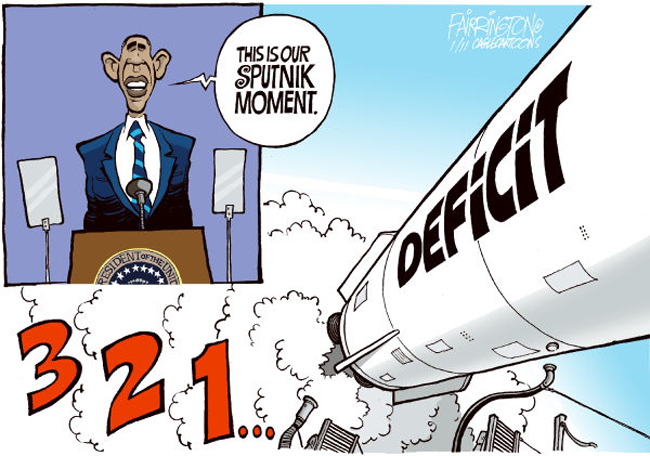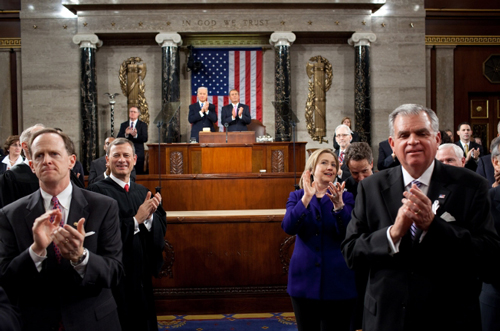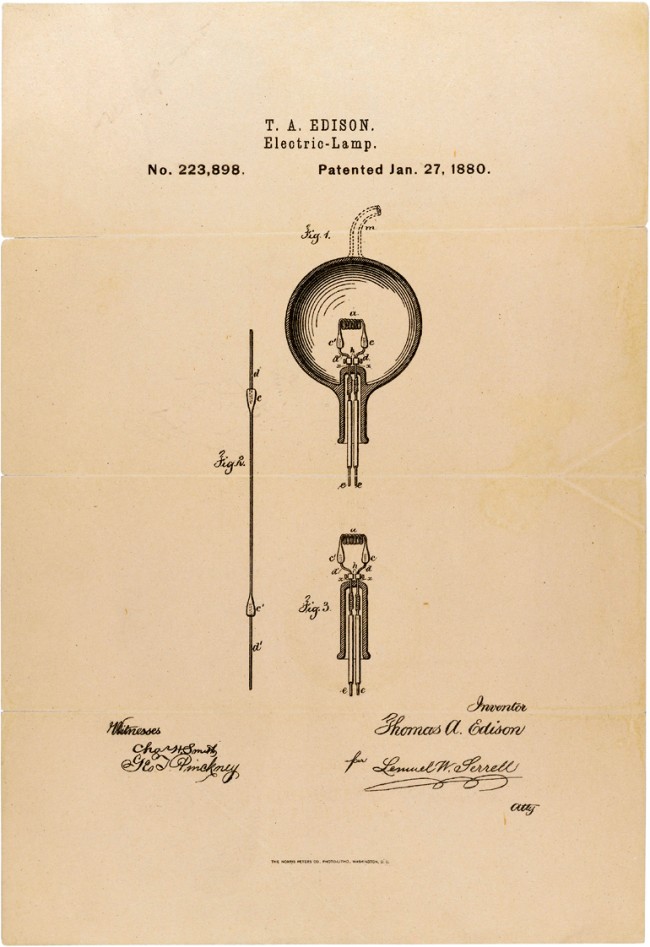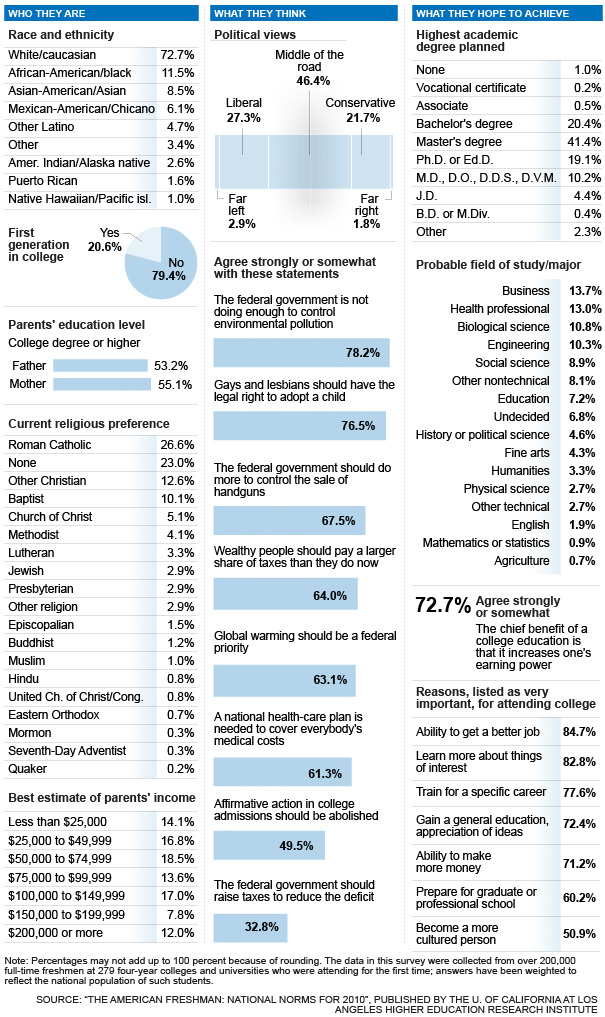
You’re welcome to send your Live Wire news tips or suggestions to [email protected].
Today’s Live Wire: Quick Links
- A Cure for Alzheimer’s?
- Cancer Nurse Navigator at Florida Hospital
- Flagler Declared Agriculture Disaster Area
- Obama: the Sputnik Moment That Wasn’t
- 2011 Deficit: $1.5 Trillion
- Arizona’s gun-death rate among the worst
- Thomas Edison’s Light Bulb
- Wikipedia Animated
- Disney Princesses Harmful to Girls
- Chart Porn: This Year’s Freshmen
- Violence and Public Discourse at Stetson
- A Few Good Links
![]()
http://www.floridatrend.com/article.asp?aID=54417
Live Wire Rewinds
![]()
 Curiously, this story has not gotten much play outside of West Virginia. This is based on research at the University of West Virginia. From the Charleston Gazette: “West Virginia researchers have found a promising treatment that might reverse the debilitating effects of Alzheimer’s disease, and offer the first step toward a potential cure for the more than 5 million Americans who suffer from it. In a study published this month in the Journal of Neuroscience, researchers at the Blanchette Rockefeller Neuroscience Institute have found the potential root cause of Alzheimer’s, and a way to treat the symptoms of the disease. The degeneration of synapses — the point of connection between two nerve cells — in the brain plays a critical role in the development of dementia in Alzheimer’s patients, said Dr. Daniel Alkon, co-author of the study and scientific director of the BRNI at the West Virginia University Robert C. Byrd Health Sciences Center. For decades, though, the thrust of research and pharmaceutical development has not been toward synapses loss but trying to reduce the amyloid plaques and neurofibrillary tangles – twisted fibers found inside the brain’s cells – that form in the brain after the loss of synapses, Alkon said. “Alzheimer’s disease is not primarily a disease of plaques and tangles, as many had previously concluded,” Alkon said. “It is most importantly a disease of synapses.” […] By targeting synapses loss, researchers have found a potential way to stop the development of plaques and tangles in the brain that contribute to dementia and other hallmarks of Alzheimer’s, “virtually eliminating all other elements of the disease,” Alkon said.” The full story.
Curiously, this story has not gotten much play outside of West Virginia. This is based on research at the University of West Virginia. From the Charleston Gazette: “West Virginia researchers have found a promising treatment that might reverse the debilitating effects of Alzheimer’s disease, and offer the first step toward a potential cure for the more than 5 million Americans who suffer from it. In a study published this month in the Journal of Neuroscience, researchers at the Blanchette Rockefeller Neuroscience Institute have found the potential root cause of Alzheimer’s, and a way to treat the symptoms of the disease. The degeneration of synapses — the point of connection between two nerve cells — in the brain plays a critical role in the development of dementia in Alzheimer’s patients, said Dr. Daniel Alkon, co-author of the study and scientific director of the BRNI at the West Virginia University Robert C. Byrd Health Sciences Center. For decades, though, the thrust of research and pharmaceutical development has not been toward synapses loss but trying to reduce the amyloid plaques and neurofibrillary tangles – twisted fibers found inside the brain’s cells – that form in the brain after the loss of synapses, Alkon said. “Alzheimer’s disease is not primarily a disease of plaques and tangles, as many had previously concluded,” Alkon said. “It is most importantly a disease of synapses.” […] By targeting synapses loss, researchers have found a potential way to stop the development of plaques and tangles in the brain that contribute to dementia and other hallmarks of Alzheimer’s, “virtually eliminating all other elements of the disease,” Alkon said.” The full story.
See Also:
- Course correction needed for Alzheimer’s therapies, experts warn
- Alzheimer’s Health Guide
- Locked and Loaded for Dignity Deserved but Withheld
Cancer Nurse Navigator at Florida Hospital Flagler

From Lindsay Rew at Florida Hospital Flagler: “Florida Hospital Flagler Cancer Institute has introduced a new way to help cancer patients navigate through what can be an overwhelming, frightening and difficult journey. The hospital has hired Leslie Baker, RN as a nurse navigator to serve as a single point of contact for cancer patients and their families and assist in all aspects of the cancer patient’s care experience. Baker meets individually with patients and caregivers and offers education, referrals and support services. As a patient’s personal guide, she steers patients through the psychological, emotional and financial challenges associated with cancer.
“My mother passed away in 1995 from pancreatic cancer. There was no one to speak with regarding her appointments, treatments, surgeries, medications, or education. It was all so overwhelming,” she said. “It gave me first-hand experience on why this new service is so necessary for patients and their families.” Baker, an Ormond Beach resident and Accredited Case Manager, began her nursing career in Medical-Surgical and GYN/Obstetrics and has spent the past nine years in case management and assisting patients with cancer diagnoses. This new service comes on the heels of Florida Hospital Fish Memorial and Florida Hospital Memorial Medical Center’s newly implemented nurse navigation programs, which began in the fall of 2010.”
See Also:
- City OKs Hospital Growth—and Exceptions to Height, Density and (Maybe) Sign Rules
- Florida Hospital Flagler’s PR Push: Lindsay Rew
Flagler Declared an Agriculture Disaster Area
 Flagler is one if 34 Florida counties the U.S. Secretary of Agriculture declared a natural disaster area on Wednesday, due to freezes and droughts over the last six months, opening the way for farmers to apply for federal aid. Adam Putnam, the state agriculture commissioner, said that an additional 28 counties are contiguous to those designated as part of the disaster area, which makes farmers in those additional counties eligible for federal aid as well. That means just five of Florida’s 67 counties are excluded from the disaster and contiguous zone. Farmers whose crops or livestock were affected have eight months to apply for loans through the Farm Service Agency (FSA) and other agencies. “President Obama and I understand these conditions caused severe damage to corn, cotton, soybeans, pasture and forage, and a wide variety of vegetable crops,” said U.S. Agriculture Secretary Tom Vilsack, who declared 45 of the state’s 67 counties in the disaster area. “This action will provide help to hundreds of farmers who suffered significant production losses.”
Flagler is one if 34 Florida counties the U.S. Secretary of Agriculture declared a natural disaster area on Wednesday, due to freezes and droughts over the last six months, opening the way for farmers to apply for federal aid. Adam Putnam, the state agriculture commissioner, said that an additional 28 counties are contiguous to those designated as part of the disaster area, which makes farmers in those additional counties eligible for federal aid as well. That means just five of Florida’s 67 counties are excluded from the disaster and contiguous zone. Farmers whose crops or livestock were affected have eight months to apply for loans through the Farm Service Agency (FSA) and other agencies. “President Obama and I understand these conditions caused severe damage to corn, cotton, soybeans, pasture and forage, and a wide variety of vegetable crops,” said U.S. Agriculture Secretary Tom Vilsack, who declared 45 of the state’s 67 counties in the disaster area. “This action will provide help to hundreds of farmers who suffered significant production losses.”
Most residents of Flagler County don’t realize it: agriculture is a dominant force in the local economy. “After one of the coldest Decembers in Florida’s history, our state is facing significant crop loss and damage. Now that USDA has granted this disaster declaration, Florida’s agriculture community can begin the long road to recovery,” U.S. Rep. Tom Rooney, a Florida Republican and a member of the House Agricultureal Committee, said. “Florida agriculture is vital not just to our state and local economies, but to our nation’s economy. This disaster declaration will help our vital agriculture industry get back in the business of feeding America.”
See Also:
- Federal Farm Service Agency
- Photo Gallery: Bunnell’s 2nd Annual Potato Festival
- All Potatoes All the Time in Bunnell’s Festival
Obama: the Sputnik Moment That Wasn’t

Jonathan Schell in The Nation: “I haven’t noticed any surprising new satellites in the heavens recently. Why, then, does the president of the United States say that we are in a “sputnik moment?” Why has that moment, now more than a half century past, been dragged out of obscurity to define the present? And why was the associated theme of American competitiveness in the world market chosen as the theme of the President’s State of the Union speech? After all, no superpower is aiming terrifying new weapons at the United States, as the Soviet Union seemed to be doing with its ballistic rockets during the Cold War. As a matter of fact, even this was an illusion. The Soviet lead in rocketry almost immediately gave way to clear US superiority, although the mistaken belief in a “missile gap” persisted for years and was in fact instrumental in producing the Cuban missile crisis. […] It seems, then, that our new “sputnik moment” is no more real than the first one. The difference is that it took a while to puncture the illusion of the original while the emptiness of the remake is immediately apparent. There’s so much Obama could have addressed but didn’t. […] It was a boring speech. It did not contain a single elegant or memorable phrase – and this from the man who rose to eminence and then power very much on the basis of his remarkable eloquence. Where was our golden-tongued young man of a few years ago? Obama’s poll numbers are up, but his muse has turned her back on him. Neither did the speech have any of the excitement, the neural sparks that fly, when words get traction with reality, and you feel in your bones, though it hasn’t quite happened yet, that something is actually going to happen. The coda was especially bad – a pastiche of clichés. (“The spirit that has sustained this nation for more than two centuries lives on in you, its people.”) Taking off from such a launch pad, Obama’s rhetoric, unlike Sputnik all those years ago, could not soar. How could it when its apparent purpose was to evade, not face, the prime realities that confront – and divide – our country.” The full essay.
See Also:
- Fact-checking Obama’s State of the Union speech
- Obama Averages 46.7% Approval in 2nd Year
- Obama Caving on Tax Cuts
- A Confederacy of Bipartisan Dunces
- State of the Union 2010
- State of the Union 2011
 From the Wall Street Journal: “The federal budget deficit will reach a record of nearly $1.5 trillion in 2011 due to the weak economy, higher spending and fresh tax cuts, congressional budget analysts said, in a stark warning that will drive the growing battle over government spending and taxation. At that size, the deficit—up from $1.29 trillion in 2010—would be roughly $60 billion more than the White House projected last summer, the nonpartisan Congressional Budget Office said Wednesday. Last year’s tax-cut package alone will add roughly $400 billion to the deficit, the CBO said. As a percentage of the nation’s economic output, the 9.8% deficit would be the second-largest since World War II, behind only the 10% level in 2009. The grim outlook landed a day after President Barack Obama outlined plans to push for new spending that he said would help keep the U.S. globally competitive in his State of the Union speech, and the data could complicate that effort. Republicans have dismissed the president’s plans as ignoring the more pressing need to reduce the deficit. […] Many of the budget-cutting proposals from Democrats and Republicans focus on a relatively small part of the U.S.’s $3.5 trillion budget: the roughly 15% that accounts for nonsecurity, discretionary spending. But the deficit is being driven by programs that are more politically difficult to cut, such as the Medicare health plan for seniors, military spending and Social Security. […] Mr. Obama proposed on Tuesday a five-year freeze on nonsecurity discretionary spending, a move officials say will save $400 billion over 10 years. But his State of the Union speech focused more on the need to continue investing in education and infrastructure than on the need to cut spending. […] Meanwhile, the U.S. debt is expected to increase rapidly in the coming years, compounded by rising health-care costs, the aging baby boomer generation and soaring interest payments. By 2017, the level of U.S. debt subject to the debt ceiling will hit $20.9 trillion, the CBO projected.” The full story.
From the Wall Street Journal: “The federal budget deficit will reach a record of nearly $1.5 trillion in 2011 due to the weak economy, higher spending and fresh tax cuts, congressional budget analysts said, in a stark warning that will drive the growing battle over government spending and taxation. At that size, the deficit—up from $1.29 trillion in 2010—would be roughly $60 billion more than the White House projected last summer, the nonpartisan Congressional Budget Office said Wednesday. Last year’s tax-cut package alone will add roughly $400 billion to the deficit, the CBO said. As a percentage of the nation’s economic output, the 9.8% deficit would be the second-largest since World War II, behind only the 10% level in 2009. The grim outlook landed a day after President Barack Obama outlined plans to push for new spending that he said would help keep the U.S. globally competitive in his State of the Union speech, and the data could complicate that effort. Republicans have dismissed the president’s plans as ignoring the more pressing need to reduce the deficit. […] Many of the budget-cutting proposals from Democrats and Republicans focus on a relatively small part of the U.S.’s $3.5 trillion budget: the roughly 15% that accounts for nonsecurity, discretionary spending. But the deficit is being driven by programs that are more politically difficult to cut, such as the Medicare health plan for seniors, military spending and Social Security. […] Mr. Obama proposed on Tuesday a five-year freeze on nonsecurity discretionary spending, a move officials say will save $400 billion over 10 years. But his State of the Union speech focused more on the need to continue investing in education and infrastructure than on the need to cut spending. […] Meanwhile, the U.S. debt is expected to increase rapidly in the coming years, compounded by rising health-care costs, the aging baby boomer generation and soaring interest payments. By 2017, the level of U.S. debt subject to the debt ceiling will hit $20.9 trillion, the CBO projected.” The full story.
See Also:
Arizona’s gun-death rate among the worst
 From the Arizona Republic: “From murders to suicides, Arizona is consistently among the most deadly states in the nation for gun violence, federal records show. Over a nine-year span, the state’s rate of gun deaths of all types ranked seventh in the United States and sixth for gun-involved slayings, according to an Arizona Republic analysis of death reports compiled by the Centers for Disease Control and Prevention. The rankings are based on data from 1999 to 2007, the most recent statistics available from the CDC. Overall, violent-crime rates in Arizona are not far from rates for the U.S. as a whole, but the rate of deaths specifically tied to guns surprises national experts. Crime-victimization patterns that measure factors such as age and racial demographics suggest that Arizona would figure to be among the states with a lower risk for violent crime. “That’s much higher than I would expect the state to be,” said Franklin Zimring, a law professor at the University of California-Berkeley who studies demographic factors in crime. “The demographic-risk profile should keep Arizona lower. It’s higher than expected. Now, the question is: Why?” […] Arizona reported more than 3,000 murders with guns over a nine-year span (1999-2007), according to CDC data. That amounts to six gun murders per 100,000 residents. The national rate was about four. Arizona’s total gun-death rate – a figure that includes murders, suicides, accidents, police shootings and other unclassified killings – was nearly 16 per 100,000. The national rate was about 10.” The full story.
From the Arizona Republic: “From murders to suicides, Arizona is consistently among the most deadly states in the nation for gun violence, federal records show. Over a nine-year span, the state’s rate of gun deaths of all types ranked seventh in the United States and sixth for gun-involved slayings, according to an Arizona Republic analysis of death reports compiled by the Centers for Disease Control and Prevention. The rankings are based on data from 1999 to 2007, the most recent statistics available from the CDC. Overall, violent-crime rates in Arizona are not far from rates for the U.S. as a whole, but the rate of deaths specifically tied to guns surprises national experts. Crime-victimization patterns that measure factors such as age and racial demographics suggest that Arizona would figure to be among the states with a lower risk for violent crime. “That’s much higher than I would expect the state to be,” said Franklin Zimring, a law professor at the University of California-Berkeley who studies demographic factors in crime. “The demographic-risk profile should keep Arizona lower. It’s higher than expected. Now, the question is: Why?” […] Arizona reported more than 3,000 murders with guns over a nine-year span (1999-2007), according to CDC data. That amounts to six gun murders per 100,000 residents. The national rate was about four. Arizona’s total gun-death rate – a figure that includes murders, suicides, accidents, police shootings and other unclassified killings – was nearly 16 per 100,000. The national rate was about 10.” The full story.
See Also:
- Miami Lawmaker “Adamantly” Wrong on Guns
- There But For the Grace of Glock Goes Florida: Arizona’s Vigilante Gun Culture
- Arizona’s Gun Culture
President Obama is chatting up a new “Sputnik moment.” Here was one of the great light-bulb moments in world history: Thomas Edison’s light-bulb patent. Here it is, from the National Archives:

See Also:
The State of Wikipedia, Animated
Disney Princesses Harmful to Girls
 From Newsweek: “In her new book, Cinderella Ate My Daughter, [Peggy] Orenstein documents her struggle to do just that: raise a daughter who is happy and self-confident amid a world that encourages little girls to engulf their rooms in pink chiffon and rhinestone tiaras. Yes, she’s talking about the princess complex—the little-girl love affair that starts with Cinderella and ends with sheets and toothbrushes and cups and tiaras and home décor and pint-size wedding gowns and myriad other products. And the ultrafeminine messages that come along with it. This princess mania, many argue, leaves girls all mixed up: while they excel in school and outpace their male peers in science and math, they also obsess about Prince Charming and who has the prettiest dress, learning—from a mix of mass marketing and media—not that girls are strong, smart, or creative, but that each is a little princess of her own, judged by the beauty of her face (and gown). Just think about the fairy tales themselves: Cinderella, Sleeping Beauty, Snow White—all pitted against evil, ugly old women (read: age = awfulness), waiting for the prince they’ve never met to fall for their beauty (not smarts) and rescue them from misery. In The Little Mermaid, Ariel literally trades in her voice for the chance a man she’s never met will love her in return. […] Much of Orenstein’s territory is well trod (there are only so many times you can hear about toddlers and beauty pageants, or the outrage over sexy Bratz dolls). But the way she sees it, there is one very big thing that separates Daisy’s generation from those who came before her—and it’s called mass marketing. Disney alone has 26,000 Disney princess items on the market today, part of a $4 billion-a-year franchise that is the fastest-growing brand the company has ever created. “What these companies will tell you is that girls want this, so they give it to them,” says Orenstein. But for girls who don’t want to play with pink princess toys, there’s virtually no other option.” The full piece.
From Newsweek: “In her new book, Cinderella Ate My Daughter, [Peggy] Orenstein documents her struggle to do just that: raise a daughter who is happy and self-confident amid a world that encourages little girls to engulf their rooms in pink chiffon and rhinestone tiaras. Yes, she’s talking about the princess complex—the little-girl love affair that starts with Cinderella and ends with sheets and toothbrushes and cups and tiaras and home décor and pint-size wedding gowns and myriad other products. And the ultrafeminine messages that come along with it. This princess mania, many argue, leaves girls all mixed up: while they excel in school and outpace their male peers in science and math, they also obsess about Prince Charming and who has the prettiest dress, learning—from a mix of mass marketing and media—not that girls are strong, smart, or creative, but that each is a little princess of her own, judged by the beauty of her face (and gown). Just think about the fairy tales themselves: Cinderella, Sleeping Beauty, Snow White—all pitted against evil, ugly old women (read: age = awfulness), waiting for the prince they’ve never met to fall for their beauty (not smarts) and rescue them from misery. In The Little Mermaid, Ariel literally trades in her voice for the chance a man she’s never met will love her in return. […] Much of Orenstein’s territory is well trod (there are only so many times you can hear about toddlers and beauty pageants, or the outrage over sexy Bratz dolls). But the way she sees it, there is one very big thing that separates Daisy’s generation from those who came before her—and it’s called mass marketing. Disney alone has 26,000 Disney princess items on the market today, part of a $4 billion-a-year franchise that is the fastest-growing brand the company has ever created. “What these companies will tell you is that girls want this, so they give it to them,” says Orenstein. But for girls who don’t want to play with pink princess toys, there’s virtually no other option.” The full piece.
See Also:
- How Disney Is Changing Education in China
- Disney’s Marketing Magic
- Disney’s Monorail System: A Primer
Chart Porn: This Year’s College Freshmen
From the Chronicle of Higher Education: “Ambitious and harried, pro-environment and pro-gay rights, waylaid by a bad economy: That’s the typical college freshman this year, according to an annual national survey by the Higher Education Research Institute at the University of California at Los Angeles. Polled during the first few weeks of the fall semester, more freshmen than ever reported having above-average academic ability and “drive to achieve.” But fewer than ever reported high levels of emotional health (see related article). Among other highs in the survey’s history were students’ expectations that they would communicate regularly with professors (38.2 percent reported a very good chance) and would study abroad (31.5 percent).” See the chart:

See Also:
Violence and Public Discourse at Stetson
 Stetson University faculty experts in political science, communication studies and sociology will address the current crisis of civility and rise of violence in public discourse during a panel discussion at 7 p.m. Thursday, Jan. 27. The program, to include a Q&A session, is free and open to the public. It will be held in the Stetson Room of the Carlton Union Building, 131 E. Minnesota Ave., DeLand.
Stetson University faculty experts in political science, communication studies and sociology will address the current crisis of civility and rise of violence in public discourse during a panel discussion at 7 p.m. Thursday, Jan. 27. The program, to include a Q&A session, is free and open to the public. It will be held in the Stetson Room of the Carlton Union Building, 131 E. Minnesota Ave., DeLand.
The panel discussion was organized in response to the tragic shooting at a public constituents meeting held by Arizona Congresswoman Gabrielle Giffords earlier this month. But the scope of the discussion will be broader. “The increasing number of militias, rise of the Tea Party, rhetoric of various politicians, extremism and violence, and individual acts of terrorism that we have witnessed in the last few years are unprecedented,” said Stetson English Professor Jamil Khader, co-chair of the university’s Diversity Council, which is sponsoring the panel discussion. Stetson experts will address the various dimensions of the problem and suggest alternative ways of communicating across the divides. The faculty panel will include: Dr. William Nylen, political science; Dr. Paul Lachelier, sociology and anthropology; Dr. Rebecca Watts, communication studies; Dr. William Ball, political science; and Dr. Michael McFarland, communication studies. The commitment to diversity is one of Stetson’s seven core values, on which the university’s academic and co-curricular activities are based. The Diversity Council is made up of faculty, staff and students who organize initiatives that foster inclusiveness and work against unfair treatment of people due to race, ethnicity, religion, economic class, disability and sexual orientation.
See Also:
- See a List of the Panelists
- More Incitement to Violence Against Florida’s Alan Grayson
- Abu Ghraib Brutality in Florida’s Youth Prisons: Suit Charges Rape and Other Abuses
- The Roots of Fox News
- ‘Hosni Mubarak, the plane is waiting’
- The religious crisis of American liberalism
- Mubarak Should Go — But Not Yet
- Ted Haggard: I’m Probably What The Kids Call ‘Bisexual’




























Leave a Reply